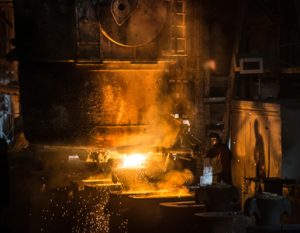[breadcrumb]
How a Steel Mill Worker Can Get Mesothelioma by Occupational Exposure to Asbestos
Steel and ironworkers are among the highest risk of asbestos exposure. Asbestos was used throughout the steel industry because of its durability, lightweight nature, affordability and fireproofing ability. Steel mill workers were usually exposed to asbestos from directly handling machinery, material and equipment while manufacturing steel.
Asbestos insulation was commonly used in various steel mill equipment, such as:
- Hot blast stoves
- Ovens
- Furnaces
- Boilers
- Steam pipes
- Tanks
- Rolling mills
- Molding boards
- Cranes
The insulation helped prevent fires and burns. However, as the materials wore out over time, asbestos fibers could become dislodged and steel mill workers could breathe in the fibers. These fibers could become lodged in the lining of the lungs and possibly result in scarring. Tumors could form, eventually leading to mesothelioma.
Additionally, personal protective gear and fireproofed clothing that steel mill workers wore often contained asbestos. They wore coats, gloves, aprons and other protective clothing made with asbestos. This clothing would become worn over time and fibers would break apart, which the workers could inhale or ingest. Fibers could also become released when sharp materials or machinery would cut into the protective clothing.
Certain occupations within the steel industry were at an increased risk of asbestos exposure. Maintenance workers who came in contact with asbestos insulation and asbestos pipe and boiler wrapping were at the highest rates of asbestos exposure. Other occupations at a heightened risk of asbestos exposure include:
- Welders
- Furnace operators
- Casters
- Inspectors
- Millwrights
- Tenders
- Machine setters
- Operators
- Pourers
- Steel lathers
Asbestos was also contained in the mills through the materials used to construct them. From the 1940s to the 1970s, steel mill workers could be exposed to various construction materials made with asbestos materials, such as insulation, pipe wrapping, ceiling tiles, flooring tiles and asbestos fire bricks.
Locations in the United States with the Highest Employment Rates for Steel Mill Workers
According to the U.S. Bureau of Labor Statistics, there are currently 80,580 employees employed in the iron and steel mills and ferroalloy manufacturing industry. States with the highest employment rates for steel mill workers include:
- Pennsylvania
- Indiana
- Michigan
- Illinois
Similar Occupations as Steel Mill Workers
Some occupations that are similar to steel mill workers include:
- Assemblers
- Boilermakers
- Carpenters
- Cement masons
- Construction workers
- Fabricators
- Reinforcing iron and rebar workers
- Terraza workers
- Welders, cutters, solderers and brazers
Lawsuits and Settlements Involving Steel Mill Workers
There have been a few cases involving steel mill workers. The most notable case involved a former steel U.S. Steel mill worker who worked in a Gary Indiana plant from 1950 to 1981. A Madison County, Illinois jury found in favor of the plaintiff for $250 million in 2003. The former steel mill worker was diagnosed with mesothelioma in 2001. The plant used asbestos-containing insulation to prevent fires. The award included $50 million in compensatory damages and $200 million in punitive damages.
LTV Steel is another large steel manufacturer that filed for bankruptcy in 1986 after being named in numerous lawsuits due to exposing workers to asbestos in its facilities. During bankruptcy proceedings, LTV Steel was allowed to significantly reduce the value of retirees’ pensions and cut off medical coverage, often from workers who were adversely affected by asbestos exposure sustained while working for the company.
Studies Related to Steel Mills and Asbestos
Researchers have conducted several scientific studies regarding asbestos in steel mills. For example, a study of Belgium steelworkers found an increased rate of asbestos bodies among production and maintenance workers.
The Mesothelioma Registry of the Province of Brescia from 1980 to the present date identified 55 workers with at least five years of employment in the steel industry from a reported 289 cases of asbestos exposure. Some of the workers’ lung tissue samples were analyzed. Researchers found between 260,000 and 11 million fibers per gram of dry tissue, far above the legal limit in the United States. The highest body burden was detected in the maintenance workers at the plant.
Types of Asbestos Products Used by Steel Mill Workers
Steel mill workers may have been exposed to asbestos that was contained in materials used to insulate equipment, such as furnaces, rolling mills, boilers, cranes, steam pipes, hot blast stoves, ovens and molding boards. Brake lining in cranes and gaskets in machinery also contained asbestos.
Steel mill workers may have also worn protective clothing that was made with asbestos, such as:
- Aprons
- Gloves
- Coats
- Coveralls
- Facemasks
- Helmets
- Leggings
- Shields
Manufacturers of Asbestos Products Used by Steel Mill Workers
Some of the manufacturers that made asbestos products that steel mill workers may have come in contact with or former installers of asbestos-containing insulation products include the following:
- AK Steel
- Keystone Steel & Wire Co.
- LTV Steel
- Porter Hayden Co.
- USX Corporation
- Weirton Steel
- Wheeling-Pittsburgh Steel Corp.

